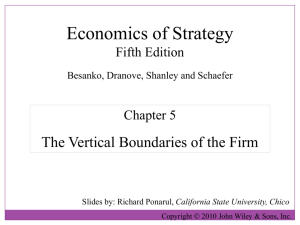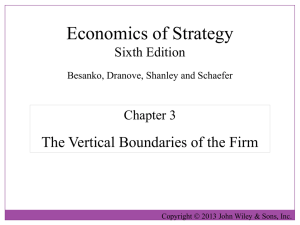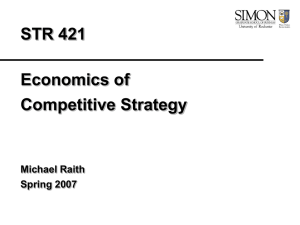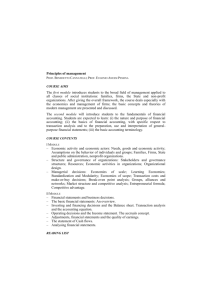The Vertical Boundaries of the Firm
advertisement
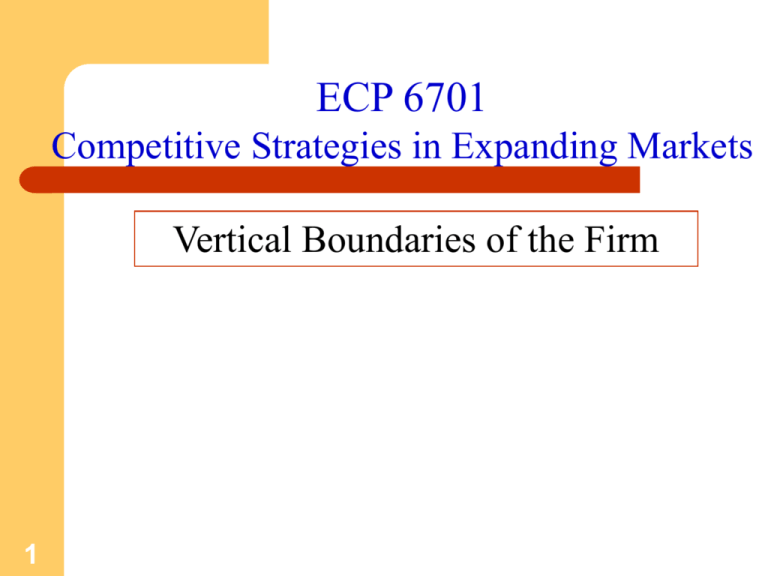
ECP 6701 Competitive Strategies in Expanding Markets Vertical Boundaries of the Firm 1 Readings 2 BDSS Chapter3 Vertical Chain 3 Begins with the acquisition of raw materials Ends with the sale of finished goods/services Includes support services such as finance and marketing Organizing the vertical chain is an important part of business strategy Vertical Boundaries of the Firm 4 Which steps of the vertical chain are to be performed inside the firm? Which steps of the vertical chain to be outsourced? Choice between the “invisible hand” of the market and the “visible hand” of the organization (Make or Buy) Make versus Buy 5 Decision depends on the costs and benefits of using the market as opposed to performing the task in-house Outside specialists may perform a task better than the firm can Intermediate solutions are possible (Examples: Strategic alliances with suppliers, Joint ventures) Support Services 6 Accounting Finance Legal Support Marketing Planning Human Resource Management Defining Boundaries Firms need to define their vertical boundaries Considerations – – – – 7 Economies of scale achieved by market firms Value of market discipline Ease of coordination of production flows in-house Transactions costs when dealing with market firms Reasons to Buy rather than Make 8 Market firms (outside specialists) may have patents/proprietary information that makes low cost production possible Market firms can achieve economies of scale that in-house units cannot Market firms are subject to market discipline, whereas in-house units may be able to hide their inefficiencies behind overall corporate success (Agency and influence costs) Economies of Scale 9 Economies of Scale 10 A given manufacturer of automobiles may not be able to reach the minimum efficient scale (A*) for anti-lock brakes An outside supplier may reach the minimum efficient scale by supplying to different automobile manufacturers Economies of Scale 11 An automobile manufacturer would rather buy anti-lock brakes from an independent supplier than from a competitor Minimum efficient scale may be feasible for the independent supplier but not for an automobile manufacturer Economies of Scale 12 Will the outside supplier charge c* (its average cost) or c’ (the average cost for the manufacturer for in-house production)? The answer depends on the degree of competition faced by the supplier Agency and Influence Costs 13 The incentives to be efficient and innovative are weaker when a task is performed in-house Agency costs are particularly problematic if the task is performed by a “cost center” within an organization It is difficult to internally replicate the incentives faced by market firms Influence costs 14 In addition to agency costs, performing a task in-house will lead to “influence costs” as well “Internal Capital Markets” allocates scarce capital Allocations can be favorably affected by influence activities Resources consumed by influence activities represent “influence costs” Reasons to Make 15 Costs imposed by poor coordination Reluctance of partners to develop and share valuable private information Transactions cost that can be avoided by performing the task in-house Each problem can be traced to difficulties in contracting Role of Contracts Firms often use contracts when certain tasks are performed outside the firm Contracts list – – 16 the set of tasks that need to be performed the remedies if one party fails to fulfill its obligation Contracts Contracts protect each party to a transaction from opportunistic behavior of other(s) Contracts’ ability to provide this protection depends on – – 17 the “completeness” of contracts the body of contract law Complete Contract 18 A complete contract stipulates what each party should do for every possible contingency No party can exploit others’ weaknesses To create a compete contract one should be able to contemplate all possible contingencies One should be able to “map” from each possible contingency to a set of actions One should be able to define and measure performances One should be able to enforce the contract Complete Contract (Continued) To enforce a contract, an outside party (judge, arbitrator) should be able to – – – 19 observe the contingency observe the actions by the parties impose the stated penalties for non-performance Real life contracts are usually incomplete contracts Incomplete Contracts Incomplete contracts – – – 20 Involve some ambiguities Need not anticipate all possible contingencies Do not spell out rights and responsibilities of parties completely Factors that Prevent Complete Contracting 21 Bounded rationality Difficulties in specifying/measuring performance Asymmetric information Bounded Rationality Individuals have limited capacity to – – – 22 Process information Deal with complexity Pursue rational aims Individuals cannot foresee all possible contingencies Specifying/Measuring Performance 23 Terms like “normal wear and tear” may have different interpretations Performance cannot always be measured unambiguously Asymmetric Information 24 Parties to the contract may not have equal access to contract-relevant information One party can misrepresent information with impurity Contract Law 25 Contract law facilitates transactions with incomplete contracts Parties need not specify provisions that are common to a wide class of transactions Limitations of Contract Law Doctrines of contract law are in broad language that could be interpreted in different ways Litigation can be a costly way to deal with breach of contract – – 26 Litigation can be time consuming Litigation weakens the business relationship Coordination of Production Flows For successful coordination one party needs to make decisions that depend on the decision made by others A good fit should be accomplished in several dimensions. Some examples are: – – – – 27 Timing Size Color Sequence Coordination Problems 28 Without good coordination, bottlenecks arise in the vertical chain Coordination is especially important when “design attributes” are present To ensure coordination, firms rely on contracts that specify delivery dates, design tolerances and other performance targets Leakage of Private Information and Outsourcing 29 Firms would not want to compromise the source of their competitive advantage Well- defined patents can help but may not provide full protection Contracts with non compete clauses can be used to protect against leakage of information In practice non-compete clauses can be hard to enforce Transactions Costs 30 If the market mechanism improves efficiency, why do so many of the activities take place outside the price system? (Coase) Costs of using the market that are saved by centralized direction – transactions costs Transactions Costs 31 Outsourcing entail costs of negotiating, writing and enforcing contracts Costs are incurred due to opportunistic behavior of parties to the contract and efforts to prevent such behavior Transactions costs explain why economic activities occur outside the price system Transactions Costs Sources of transactions costs – – – 32 Investments that need to be made in relationship specific assets Possible opportunistic behavior after the investment is made (hold up problem) Quasi-rents (magnitude of hold up problems) Relationship-Specific Assets 33 Relation-specific assets are essential for a given transaction These assets cannot be redeployed for another transaction costlessly Once the asset is in place, the other party to the contract cannot be replaced costlessly, because the parties are locked into the relationship to some degree Relationship-Specific Assets: Examples 34 An aluminum refiner invests in a refinery designed to process a particular grade of bauxite ore The French government invests in transportation infrastructure for Euro-Disney Forms of Asset Specificity Relation-specific assets may exhibit different forms of specificity – – – – 35 Site specificity Physical asset specificity Dedicated assets Human asset specificity Rent and Quasi-rent 36 The term ‘rent” denotes economic profits – profits after all the economic costs, including the cost of capital, are deducted Quasi-rent is the excess economic profit from a transaction compared with economic profits available form an alternate transaction Rent and Quasi-rent 37 Firm A makes an investment to produce a component for Firm B after B as agreed to buy from A at a certain price At that price A can earn an economic profit of π1 If A were to renege on the agreement and B is forced to sell its output in the open market, the economic profit will be π2 Rent and Quasi-rent 38 Rent is the minimum economic profit needed to induce A to enter into this agreement with B (π1) Quasi-rent is the economic profit in excess on the minimum needed to retain A in the selling relationship with B (π1- π2) The Holdup Problem 39 Whenever π1 > π2, Firm B can benefit by holding up A and capturing the quasi-rent for itself A complete contract will not permit the breach With incomplete contracts and relationshipspecific assets, quasi-rent may exist and lead to the holdup problem Effect on Transactions Costs The holdup problem raises the cost of transacting exchanges – – – – 40 Contract negotiations become more difficult Investments may have to be made to improve the ex-post bargaining position Potential holdup can cause distrust There could be underinvestment in relation specific assets Holdup and Contract Negotiations 41 When there is potential for holdup, contract negotiations become tedious as each party attempts to build in protections for itself Temptations on the part of either party to holdup can lead to frequent renegotiations There could be costly disruptions in the exchange Holdup and Costly Safeguards Potential for holdup may lead parties to invest in wasteful protective measures – – 42 Manufacturer may acquire standby production facility for an input that is to be obtained from a market firm Floating power plants are used in place of traditional power plants to avoid site specific investments Holdup and Distrust Potential holdups cause distrust between parties and raise the cost of transactions – – 43 Distrust can make contracting more costly since contracts will have to be more detailed Distrust affects the flow of information needed to achieve process efficiencies Holdup and Underinvestment 44 When there is a holdup, the investment made in relationship-specific assets loses value Anticipating holdups, firms will make otherwise sub-optimal level of investments and suffer higher production costs Asset Specificity and Transactions Costs Relation-specific assets support a particular transaction Redeploying to other uses is costly Quasi rents become available to one party and there is incentive for a holdup Potential for holdups lead to – – – 45 Underinvestment in these assets Investment in safeguards Reduced trust Summary 46 Production activities flow from upstream suppliers to downstream manufacturers, distributors, and retailers (vertical chain). The “make or buy” problem determines the vertical boundaries of a firm. The solution to this problem depends on option leads to most efficient production. This requires an assessment of the cost and benefits of using the market. Summary 47 Market firms can exploit economies of scale to produce a component cheaper. Market firms are subject to competition which encourages efficiency and innovation. Vertically integrated firms might face agency and influence costs. Summary 48 Use of market transactions entails coordination problems (especially for production of inputs with complex design requirements). Use of market transactions may lead to lose control of valuable private information. Use of market transaction might entail contracting costs.
